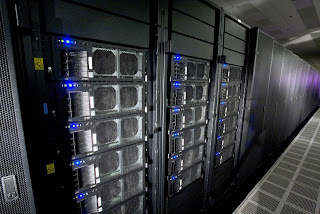Roadrunner is the Fastest Supercomputer
 Roadrunner (photo courtesy: Los Alamos National Laboratory, Berkeley)
Roadrunner (photo courtesy: Los Alamos National Laboratory, Berkeley)With the publication of the latest edition of the TOP500 list of the world’s most powerful supercomputers, the global high performance computing community has officially entered a new realm—a supercomputer with a peak performance of more than 1 petaflop/s (one quadrillion floating point operations per second).
The new No. 1 system, built by IBM for the U.S. Department of Energy’s Los Alamos National Laboratory and and named “Roadrunner,” by LANL after the state bird of New Mexico achieved performance of 1.026 petaflop/s—becoming the first supercomputer ever to reach this milestone. At the same time, Roadrunner is also one of the most energy efficient systems on the TOP500.
The 31st edition of the TOP500 list was released at the International Supercomputing Conference in Dresden, Germany. Since 1993, the list has been produced twice a year and is the most extensive survey of trends and changes in the global supercomputing arena.
The Roadrunner system is based on the IBM QS22 blades which are built with advanced versions of the processor in the Sony PlayStation 3, displaces the reigning IBM BlueGene/L system at DOE’s Lawrence Livermore National Laboratory. Blue Gene/L, with a performance of 478.2 teraflop/s (trillions of floating point operations per second) is now ranked No. 2 after holding the top position since November 2004.
Rounding out the top five positions, all of which are in the U.S., are the new IBM BlueGene/P (450.3 teraflop/s) at DOE’s Argonne National Laboratory, the new Sun SunBlade x6420 “Ranger” system (326 teraflop/s) at the Texas Advanced Computing Center at the University of Texas – Austin, and the upgraded Cray XT4 “Jaguar” (205 teraflop/s) at DOE’s Oak Ridge National Laboratory.
Among all systems, Intel continues to power an increasing number, with Intel processors now found in 75% of the TOP500 supercomputers, up from 70.8% of the 30th list released last November.
Other highlights from the latest list include:
-- Quad-core processor based systems have taken over the TOP500 quite rapidly. Already 283 systems are using them. Two hundred three systems are using dual-core processors, only eleven systems still use single core processors, and three systems use IBMs advanced Sony PlayStation 3 processor with 9 cores.
-- The top industrial customer, at No. 10, is the French oil company: Total Exploration Production.
-- IBM held on to its lead in systems with 210 systems (42%) over Hewlett Packard with 183 systems (36.6%). IBM had 232 systems (46.4%) six months ago, compared to HP with 166 systems (33.2%).
-- IBM remains the clear leader in the TOP500 list in performance with 48% of installed total performance (up from 45), compared to HP with 22.4% (down from 23.9). In the system category Dell, SGI and Cray follow with 5.4%, 4.4% and 3.2% respectively.
-- The last system on the list would have been listed at position 200 in the previous TOP500 just six months ago. This is the largest turnover rate in the 16-year history of the TOP500 project.
For the first time, the TOP500 list will also provide energy efficiency calculations for many of the computing systems and will continue tracking them in consistent manner. Most energy efficient supercomputers are based on
IBM QS22 Cell processor blades (up to 488 Mflop/s/Watt),
IBM BlueGene/P systems (up to 376 Mflop/s/Watt)
Intel Harpertown quad-core blades are catching up fast:
IBM BladeCenter HS21with low-power processors (up to 265 Mflop/s/Watt)
SGI Altix ICE 8200EX Xeon quad-core nodes, (up to 240 Mflop/s/Watt) ,
Hewlett-Packard Cluster Platform 3000 BL2x220 with double density blades (up to 227 Mflop/s/Watt).
The U.S. is clearly the leading consumer of HPC systems with 257 of the 500 systems. The European share (184 systems – up from 149) is still rising and is again larger then the Asian share (48 – down from 58 systems). Dominant countries in Asia are Japan with 22 systems (up from 20), China with 12 systems (up from 10), India with 6 systems (down from 9), and Taiwan with 3 (down from 11).


0 Comments:
Post a Comment
<< Home